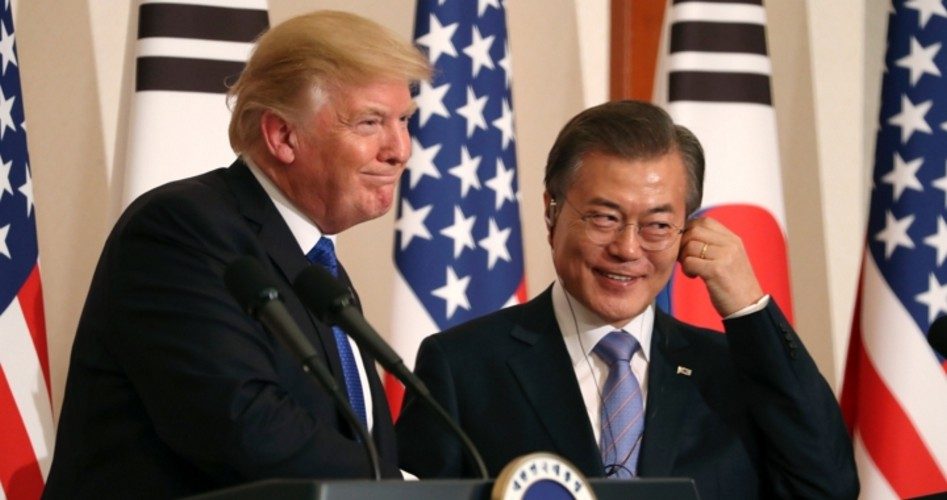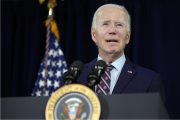
Speaking during a joint press conference with South Korea’s President Moon Jae-in (shown) in Seoul on November 7, President Trump invited the leaders of communist North Korea “to come to the table and to make a deal that’s good for the people of North Korea and the people of the world.” While one reporter in the Washington Post described the president’s words as “conciliatory,” they were said in the context of a description of U.S. military strength in the region of the Korean peninsula.
Trump first stated, “I believe it makes sense for North Korea to do the right thing, not only for North Korea, but for humanity all over the world. So there is a lot of reason, a lot of good reason behind it.”
He then proceeded to show that any deal that the United States struck with Pyongyang would be negotiated from a position of strength, not weakness:
With that, yes, I think we’re making a lot of progress. I think we’re showing great strength. I think they understand we have unparalleled strength. There has never been strength like it.
You know we sent three of the largest aircraft carriers in the world, and they’re right now positioned. We have a nuclear submarine also positioned. We have many things happening that we hope, we hope — in fact, I’ll go a step further, we hope to God we never have to use.
In addition to visiting with Moon at the Blue House — South Korea’s presidential residence — Trump also visited with U.S. and South Korean troops on November 7 at Camp Humphreys, a U.S. Army garrison south of Seoul and about 60 miles from the Demilitarized Zone (DMZ).
During his visit, the president went to the mess hall to have lunch with troops. He was accompanied by Moon, Secretary of State Rex Tillerson, Chief of Staff John F. Kelly, and National Security Advisor H.R. McMaster.
“Ultimately, it will all work out. It always works out. It has to work out,” Trump said at the start of a briefing with military commanders at the base, referring to U.S. diplomatic efforts to counter the threat from North Korea.
During his visit to the base, when a reporter asked Trump if he still thought negotiations with North Korea would be a waste of time, the president replied, “I don’t want to say that — I just don’t want to say that. You can understand.”
During his visit to Seoul, some of Moon’s “progressive” supporters, who supported their president’s efforts to open a dialogue with the North, demonstrated against Trump’s visit.
“Don’t come, Trump! You talk about war whenever you open your mouth,” read a message on a large banner displayed during a protest near the American embassy on November 7. “Go away, Trump!” shouted hundreds of protestors. “No Trump, no war!”
There were also demonstrations in favor of the visiting American president, noted the New York Times. Hundreds of conservatives welcomed Trump with South Korean and American flags.
The Times noted that South Korean conservatives have expressed reservations about Moon’s approach to Pyongyang, calling it naïve. They are supportive of Trump’s more hard-line view of the North, although they do not support war against their neighbor to the North.
“We believe in Trump!” read some of their signs.
South Korea was the second country that the president and Mrs. Trump visited on their Asian trip, which began at Yokota Air Base, a U.S. facility in Japan, on November 5. During that stop, the Trumps met with Japanese Prime Minister Shinzo Abe and Mrs. Akie Abe.
On November 8, President Trump arrived in China. According to BBC News, the Trump administration “sees China as pivotal in reining in the North’s nuclear aims but Beijing says it is doing enough.” The White House website noted that Trump and Chinese President Xi Jinping will “discuss ways to continue to apply pressure on North Korea” and that Trump will “stress the unsustainability of China’s unfair trade practices that have produced a massive trade deficit, and the President will reaffirm his determination to defend America’s economic interests.”
The White House post about the Asian trip stated that the President will continue on to Vietnam, where he will address the APEC CEO Summit in Da Nang and “outline the United States’ vision of a free and open Indo-Pacific region where free, fair, and reciprocal trade, and private sector-led investment and growth generate prosperity and protect the sovereignty of all.” Trump will visit Hanoi for an official state visit and meet with President Quang of Vietnam and other senior Vietnamese leaders.
The presidential trip will conclude in the Philippines, where Trump will hold bilateral meetings with President Rodrigo Duterte, Prime Minister Narendra Modi of India, and Prime Minister Malcolm Turnbull of Australia. While there, he will also attend the U.S.-ASEAN Summit and East Asia Summit.
Photo: AP Images
Related articles:
What Does the U.S.-North Korean War of Words Really Mean?
North Korea Not Interested in Diplomacy Until It Has ICBM Capable of Reaching U.S. East Coast
Official Says North Korean Missile Has “.00001 Percent Chance” of Getting Through Defenses
North Korea Tests Ballistic Missile Capable of Reaching U.S. Base on Guam
In Test That Will Send Message to N. Korea, U.S. Successfully Intercepts ICBM
Successful Test of THAAD Anti-missile System Offers Hope for U.S. Defense
South Korea Says North Korean ICBM Lacks Re-entry Capability
Aircraft Carriers Gather Off N. Korea; Pyongyang Tests Missile Able to Hit Ships
Recently Tested North Korean ICBM Said to be in Range of Most of U.S.
N. Korea Continues Missile Tests; U.S. Moves 3rd Carrier Strike Force to Western Pacific
North Korea Tests Another Missile, Says They Are Ready to Deploy
North Korea Threatens U.S. With “All Out War” and “Weekly Missile Tests”
North Korea Threatens to Attack U.S. Carrier Group; Detains U.S. Citizen
North Korea Warns of Nuclear Retaliation at Any Sign of U.S. “Aggression”
North Korea Admits Missile Launches Were Test of Possible Strike Against U.S.Bases in Japan


